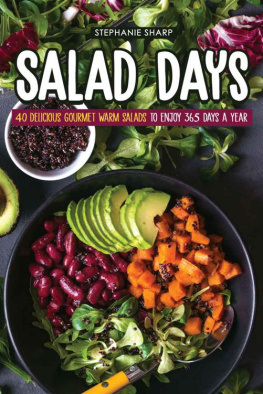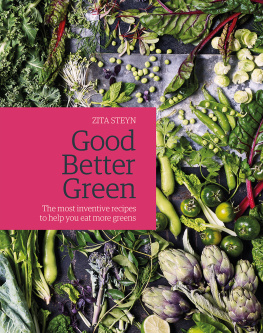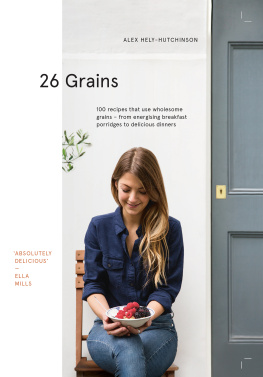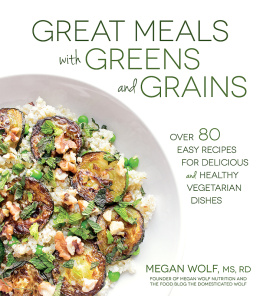All rights reserved. No portion of this book may be reproduced or utilized in any form, or by any electronic, mechanical, or other means, without the prior written permission of the publisher.
Library of Congress Cataloging-in-Publication Data is available.
INTRODUCTION
C AN A SALAD MAKE YOU HAPPY ? I would like to think so. Salads, by nature, are healthy and clean, and there is a peaceful cadence and stillness to experience in preparing a meal. Its often one of the few times during the day I get to focus on a singular, intuitive task that results in nurturing my body and perhaps even those of my family and friends. What more can you ask for in the day? All the salads in this book will fuel you. With no heavy ingredients to weigh you down, the recipes in Salad Days supply you with delicious, pretty, and healthy salads to enrich your life. Slow down, take ten minutes, reflect on all the beautiful things in your life, and then sit and enjoy the process of self-nurturing by way of a well-prepared meal.
In recent years, salads have moved from side-dish afterthoughts to main meals. Parents are looking for healthy choices that are easy-to-whip-together crowd-pleasers, while single-person households are often reaching for healthy choices that dont require a lot of time in the kitchen. Here, Ive channeled all of my salad prowess into one go-to cookbook for anyone wanting to add more veggies to their diet and for all home cooks in need of some fresh, seasonal salad ideas. Salads are one of those quintessential in-a-food-rut dishes. Bagged salad greens get tossed in a store-bought dressing with little thought to texture or flavor. Often, a salad is used solely as a way to add greens to a diet. Salad Days hopes to help break this pattern and offer readers a yearlong guide to healthy and seasonal salads that can be eaten as sides or treated as a complete meal.
Salad Days is approachable and applicable to lifeno one needs another fancy cookbook with obscure ingredients. Salad Days uses typical pantry ingredients as well as trending favorites (miso, fish sauce, etc.) that can be found in , and it teaches people how to build on concepts to create their own salad.
On their own, vegetables are not really that captivating. Tasty? Yes. Those natural sugars and strong fibers are interesting, and their health benefits compelling, but seldom do you bite into a leaf of lettuce and roll your eyes in ecstasy.
To really dial up the flavor in a salad, we add herbs, spices, and toppings or make flavor-bomb vinaigrettes. Herein lies the magic of this book. Dont spend too much time fretting over whether you have a certain lettuce on handthe best part is the additions. Salad Days is packed with tips. Any time you fire up the oven, throw a few cloves of garlic onto a roasting sheet for some future dressing, like the . If the oven is on, you may as well multitask to build up your salad pantry and make good use of the energy youre consuming. If youre making candied pecans for one salad, make a double batch so there are extras to throw on a salad later that month. When you start working in this fashion, planning for meals no longer becomes a huge project.
There is one crucial and universal rule to keep in mind when making a salad. Acids and liquid break down greens quickly, so plan ahead. If youre prepping all the ingredients ahead of time, dont stir in the salad greens until immediately before serving. If you know youll have leftovers (such as if youre a two-person household), split the recipes in half and add greens just before eating. Beans will hold in the refrigerator for daysdressed greens will not.
Homemade vinaigrettes and dressings are my favorite salad-making additionchanging up the oil or acid is a simple act that produces delightful results. I love them so much I included an entire chapter (see ) with foundational ideas you can expand on, moving from simple vinaigrettes to creamy dressings. A bowl of greens can be boring, but dress it one day with lemon and oil and the next with a rich blend of avocado-miso, and youll soon see just how captivating salads can be.


Typically I like a well-dressed salad, and the recipes here will reflect that. I dont like salad greens to wilt and turn slimy, nor do I like a thick coating of dressing on a tender green. However, I equally dislike when I eat a forkful of raw lettuce with nary the flavor of vinaigrette! I like to think all the recipes here strike a balance and everything is perfectly dressed. Additionally, extra vinaigrette in the bowl doesnt bother me, and I make a habit of saving any leftover dressing, adding it to a jar in the refrigerator for the next salad.
All vinaigrettes pretty much follow the same mathacid plus oil plus spices, and in this way, the flavors build on each other and morph as new ingredients are added. Think of this as a vinaigrette starter. This is especially true of fruit saladsberries, mangoes, and tomatoes all release their juices into the vinaigrette and leave behind a gentle acid and a fruity flavor that is a shame to wash away at the end of the meal. The only time I dont save leftovers is if Im making a creamy dressing. Those have a different flavor profile and wont blend as seamlessly, so be sure to dress the salad and add more dressing only as needed. Any leftover dressing can often be held in the refrigerator, and notes on this are given through the chapters.
















